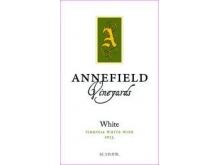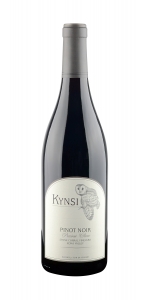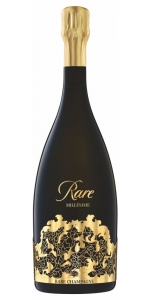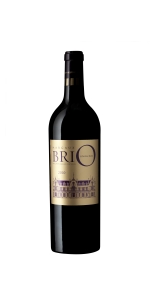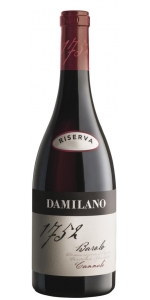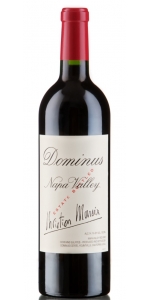Annefield White Blend 2013
| Country: | United States |
| Region: | Virginia |
| Winery: | Annefield Vineyards |
| Grape Types: | Petit Manseng Chardonnay Riesling Viognier Traminette Vidal Blanc |
| Vintage: | 2013 |
| Bottle Size: | 750 ml |
The Stone Corral Vineyard is planted on a southeast slope on the west side of the Edna Valley which has an east/west orientation opening up to the Pacific Ocean from Morro Bay and Pismo Beach. Approximately 120 to 300 feet above sea level, the climate is strongly influenced by the ocean providing ideal temperate growing conditions for Pinot Noir. Early spring warming, mild summer temperatures and late arriving cold fall temperatures and rain provide a long growing season for the development of rich color, concentrated and complex flavors. Soil profiles vary between blocks from sand, sandy loam, loamy sand, pebbly sandy clay loam, all fine angular blocky , including decomposing sandstone layers and numerous fossil rocks. The soils are well drained and marine in origin, resulting in an elegant Pinot Noir with extraordinary attributes.
This gem is a blend of a few precious, select barrels hailing from the finest blocks of Stone Corral Vineyard. Offers blue-toned fruit on the nose and a pretty bouquet of black raspberry, sandstone, marzipan and wild lupine flowers. Opulent, yet delicate on the palate, with velvety layers of cola nut, cherry, dried herbs and pecan sandie cookies.
Wine analysis – 13.7% Alcohol, .69 TA, 3.5pH
- A barrel select Stone Corral Vineyard bottling, utilizing the finest blocks and clones of the 2013 vintage
- Blend of clones 115, 777 and 667 on 101-14 and 3309 rootstalks
- Hand harvested, cold fruit from night picks during the month of September 2013
- Yield about 2 tons per acre between 23.8 and 24.5 ° Brix
- Destemmed with nearly 100 % whole berries remaining
- Fermented in small open top tanks
- 4 day cold soak, average 14 day fermentation, peak temperature 83°
- Hand punched down several times daily as needed
- Pressed off just dry, tank settled then racked to barrels
- Aged in small French oak barrels for 18 months
- Once the fresh wine is transferred from the press pan, all moving of the wine is done with inert gas pressure.
When handling the wine, care is taken at all opportunities to avoid shear.
"This bottling comes from the best blocks and barrels from this single vineyard, co-owned by a number of Edna Valley luminaries. The result is stunning, with baked raspberry, strawberry, maple, and peppery bacon aromas comprising a spicy, exotic nose. Black plum fruit melds with white pepper and crushed herbs, diving into tangy strawberry and sandalwood incense notes on the finish. - Matt Kettmann"
- Wine Enthusiast Magazine (April 1st 2017), 95 pts
Piper-Heidsieck Rare Brut Champagne is made from 70% Chardonnay, 30% Pinot Noir.
The effervescence of Rare Millésime 2013 is tinged with an intensely bright, light golden color. The nose, at first subtle and clean, emerges in two stages combining tonicity and elegance. It all begins with the delicacy of white flowers, a hint of black tea and touches of citrus, kiwi and kumquat. Then, notes of lime blossom, green tea and fern give way to aromas of white fruits such as greengage plums. Touches of chestnut honey, sweet spices, vanilla and marzipan round off the wine's rich bouquet. The two facets of Rare Millésime 2013 are confirmed in the mouth: smooth and vibrant, indulgent and dynamic. After hints of meringue, whipped cream and marzipan, kumquat, blood orange and kiwi then provide a refreshing tonicity. On the finish, the comforting texture of Rare Millésime 2013 appears as an aromatic and smoky indulgence punctuated by a freshness and a subtle bitterness. Rare Champagne's iconic signature of tropic minerality is expressed differently in Rare Millésime 2013, extended by a plump and prolonged aftertaste.
Reviews:
Originally a part of the legendary Piper-Heidsieck Champagne house, Rare is moving their Champagne Millésime to a new brand and want it to stand alone. (Think Delamotte and Salon.) The 13th vintage for this cuvée, the 2013 Champagne Millésime is a blend is 70% Chardonnay with the rest Pinot Noir, with the majority of the blend coming from the Montagne de Reims Grand Cru and Premier Cru. A bright yellow hue, its aromatics are exquisite and well-balanced, with fresh notes of key lime, candied apple, fresh croissant dough, fresh pineapple, and honeysuckle. Medium to full-bodied, it fills the palate with a rounded and supple texture and a pillowy mousse. It’s long on the palate and has a silky personality as well as a long, pristine finish. It has fantastic balance of decadence and freshness, and I could drink this all day. It’s going to have a long drinking window. Drink 2024-2044 and beyond. Disgorged December 2022.
-Jeb Dunnuck 97 Points
Like a stallion out of the gate, this shows an initial explosion of power, in the form of mouthwatering flavors and fine texture, before quickly settling into an elegant gait. The racy acidity is seamlessly knit, buoying the lacy mousse and flavors of cassis, toasted brioche and tangerine, with accents of candied ginger, hazelnut and fleur de sel lingering on the long, creamy finish.
-Wine Spectator 97 Points
A new wine for the new century: BriO de Cantenac Brown was born in 2001.
Through the style of its label, but also through the quality of our work from the selection of the lots to the bottling, it aims at expressing the modernity of our Château.
The lots supposed to be the main part of BriO are pre-selected because of their evolution all through the year, which means that we focus on each different lot of the winery, from the budburst through the flowering to the ripeness control.
A meticulous attention
The lots for BriO often need more work: more leaf pruning, some green harvest, for example on the young vines, to help them to deal with the weather conditions.
Our two labels are made from vines located on a beautiful terroir where you find gravelly soils, and we want the vinification of BriO to lead to an elegant wine with lots of flavours, a compromise between strength and finesse.
So, if you like the fruits, you can start to drink it from 2 to 5 years after the harvest.
The blend between Cabernet Sauvignon, Cabernet Franc and Merlot is different for each vintage but the Merlot percentage is usually more important than the one in the Château Cantenac Brown.
The 12 months-long ageing in 20% to 25% new oak barrels is traditional; we rack it every 3 months. Before the bottling, we do the fining with egg whites.
It is on purpose if the bottles of BriO are different from the ones of Cantenac Brown: we want BriO to become a brand on its own, and it’s true that we talk much more about “BriO” than about “BriO de Cantenac Brown”.
We want BriO to be a wine you drink before, during and after a meal; just for your pleasure.
“1752” is the name of the Damilano Barolo Cannubi Riserva, in honor of the year in which the historic bottle was first marked “Cannubi”. It still exists today perfectly conserved by the Manzone family in Bra, close to Barolo. The bottle is clearly marked as being of “1752” vintage, indicating that Cannubi historically precedes Barolo.
About the Vineyard:
The Cannubi Cru is in found within one of the 6 core zones which comprise a UNESCO heritage site in Italy. A mixture of Tortonian and Helvetian calcareous marl gives the grapes intense aromas of cherry, plum and tobacco, rose and violet in sequence. Its low potassium and high calcium/magnesium content offer the wine a fine and polished touch. The vineyard is located at about 270 m. a.s.l. and has a south-east sun exposure. Barolo Riserva Cannubi 1752 It is a small plot of about 2 hectares of Nebbiolo vines, currently between 30 and 50 years of age.
Tasting Notes:
Garnet ruby red in color, the bouquet is intense and balanced, with notes of violet, red fruit, cherry and plum, spices, liquorice, cocoa, leather and tobacco. Dry, robust, full-bodied, very persistent, rich and velvety
Food Pairing:
This wine is excellent with typical piedmontes pasta (tajarin, ravioli); perfect with red meat, braised and roast meat, game and absolutely ideal with all types of cheeses.
Review:
The purity of this wine is pretty phenomenal with blackberries, strawberries, fresh flowers and licorice. Hints of tar. It’s full-bodied, yet composed and compact with ultra fine tannins and a long, flavorful finish. Very structured. Try after 2024.
-James Suckling 97 Points
Dominus Napa Valley Red Blend is made from 88% Cabernet Sauvignon, 7% Cabernet Franc, 5% Petit Verdot.
The historic Napanook Vineyard, a 124-acre site west of Yountville, was planted in 1838. This vineyard was the source of fruit for some of the finest Napa Valley wines. Estate-bottled in the spirit of the Bordeaux châteaux, Dominus Estate is dry-farmed to allow natural stress and good concentration of fruit. Grape clusters are crop-thinned to allow sun and air to pass in between, helping to achieve full maturation and soften the tannins. Only 20% to 40% new French oak barrels are used in order to limit the extraction of oak notes. To express the unique terroir, the classic Bordeaux grape varietals of Cabernet Sauvignon, Merlot, Cabernet Franc and Petit Verdot are planted with different root stocks best suited for the varying soil composition of gravel, heavy clay and loam.
Reviews:
One of the legendary Dominus, the 2021 Cabernet Sauvignon is unquestionably in the same league as the 2018, 2016, 2015, 2013, 2010, and 1991, and to my mind, wine simply doesn't get any better. Sporting a dense purple hue as well as an incredible perfume of blackcurrants, crushed stone, cedar pencil, smoke tobacco, and baking spices, it s rich, full-bodied, and voluptuously textured, with ripe yet building tannins. It reminds me slightly of the 2010 (maybe the 2013), and I suspect it will have a similar evolution. Hide bottles for 7-8 years, and it will evolve gracefully for 30+ years. Hats off to the team of Christian Moueix and director Tod Mostero.
Jeb Dunnuck 100 Points
Dominus Napa Valley Red Blend is made from 88% Cabernet Sauvignon, 7% Cabernet Franc, 5% Petit Verdot.
The historic Napanook Vineyard, a 124-acre site west of Yountville, was planted in 1838. This vineyard was the source of fruit for some of the finest Napa Valley wines. Estate-bottled in the spirit of the Bordeaux châteaux, Dominus Estate is dry-farmed to allow natural stress and good concentration of fruit. Grape clusters are crop-thinned to allow sun and air to pass in between, helping to achieve full maturation and soften the tannins. Only 20% to 40% new French oak barrels are used in order to limit the extraction of oak notes. To express the unique terroir, the classic Bordeaux grape varietals of Cabernet Sauvignon, Merlot, Cabernet Franc and Petit Verdot are planted with different root stocks best suited for the varying soil composition of gravel, heavy clay and loam.
Reviews:
One of the legendary Dominus, the 2021 Cabernet Sauvignon is unquestionably in the same league as the 2018, 2016, 2015, 2013, 2010, and 1991, and to my mind, wine simply doesn't get any better. Sporting a dense purple hue as well as an incredible perfume of blackcurrants, crushed stone, cedar pencil, smoke tobacco, and baking spices, it s rich, full-bodied, and voluptuously textured, with ripe yet building tannins. It reminds me slightly of the 2010 (maybe the 2013), and I suspect it will have a similar evolution. Hide bottles for 7-8 years, and it will evolve gracefully for 30+ years. Hats off to the team of Christian Moueix and director Tod Mostero.
Jeb Dunnuck 100 Points
This complex blend calls to mind fresh flowers, honeysuckle and herbs, and is balanced with a wonderful, fruity, crisp acidity. Bright with tropical flavors like pineapple and mango. This wine is off-dry with a pleasant and casual demeanor. It is, in a word, "fun."
Annefield White Blend 2013 is made from 33% Traminette, 20% Vidal Blanc, 19% Chardonnay, 13% Riesling, 9% Petit Manseng, 6% Viognier
Serve with assertive dishes with Thai or Vietnamese-inspired spices or sip it on the patio or in the hot tub
Fermentation Seasoned French Oak Barrels
Harvested in September 2013
Released: Spring 2014
pH: 3.35
Total Acidity: 5.8 g/Liter
Residual Sugar: 2.5%
The Annefield Grape Varietals
AWHITE QUARTZ SAPPONY INDIAN arrowhead was found at the site, so we have christened this vineyard Arrowhead. The first three-acre vineyard planting is on Georgeville silt loam, which produces moderate vine vigor.
With our deep, well drained soils, hot summers, and relatively mild winters, the climate and soil in Charlotte County are perfect for grapevines. We are taking advantage of these great conditions and have selected grape varieties that flourish here and produce the best tasting wines. Our vineyard is situated at 500-ft. elevation in an area with excellent air drainage.
Ripening fruit at Annefield Vineyards
Ripening fruit at Annefield.
We are implementing all necessary vineyard practices to optimize the quality of our fruit. These include the use of the Vertical Shoot Positioning system to train the vines, shoot thinning and leaf pulling throughout early summer, two hedgings per season, and fruit thinning on vigorous varieties.
In April 2006, we planted our first three acres. We started with Viognier, Cabernet Franc and Cabernet Sauvignon. The Viognier and Cabernet Franc were grafted onto 3309 Couderc rootstock, and the Cabernet Sauvignon grafted onto Millardet et de Grasset 101-14. Both were selected because they are less vigorous than other rootstocks and grow well in our rich Virginia clay:
Viognier – Viognier is a white grape from the Rhone Valley that makes full-bodied, powerfully perfumed, intensely floral, spicy wines. Its rich and complex aroma is like overripe apricots mixed with orange blossoms. Other descriptors are lime, honeysuckle, jasmine, ginger, and melon. Like Chardonnay, Viognier takes well to oak and to malolactic fermentation.
Cabernet Franc – One of the major red wine grapes of the Bordeaux region, Cabernet Franc is the leaner sibling of Cabernet Sauvignon and often blended with it, not only in France but in Meritage-style New World blends. On its own it is less full-bodied, less tannic and less acidic than Cabernet Sauvignon but it may be more aromatic, fruity, herbal, or vegetal. Cabernet Franc’s primary fruit aromas often suggest raspberry, cherry, strawberry and, especially, plum. It almost always shows a distinctive aroma of violets and a slightly spicy flavor. When it shows vegetal characters, they tend toward bell pepper or stems. With oak treatment, smoke, toast, and tar characters emerge. Extended bottle age promotes earth, mushroom, and cedar aromas.
Cabernet Sauvignon – Cabernet Sauvignon is often called the “king” of red wine grapes. In the great wines of the Medoc region of Bordeaux, Cabernet Sauvignon is always blended (with Merlot, Cabernet Franc, and sometimes Petite Verdot and/or Malbec), while elsewhere in the world it may be blended, or bottled on its own. At its best, Cabernet Sauvignon produces wines of tremendous intensity and depth of flavor. It can be firmly tannic and it usually shows dark purple color, firm acidity, full body, and concentrated flavors. It has an affinity for oak and often spends a year or more in barrel, gaining vanilla, toffee, cedar, and/or coconut flavors. Typical fruit aromas of Cabernet Sauvignon are black currant, blackberry, plum, and black cherry with occasional notes of rhubarb or prune. Herbal notes of pepper, asparagus, green or black olive, mint/menthol/eucalyptus and spice notes of ginger, oregano and anise might be found. The particular appeal of Cabernet Sauvignon, however, lies less in its fruit aromas and more in the subtle flavors that develop with years of bottle aging and the complex interaction between the fruit, tannins, fermentation, alcohol and oak.
In 2011, we will plant three additional varietals: Vermentino, Pinot Grigio and Vidal Blanc, all grafted onto Millardet et de Grasset 101-14.
Vermentino – With its bright acidity, aromas of citrus leaf and mineral, and refreshing finish, this grape will most likely become a favorite at Annefield Vineyards. This late-ripening white grape variety is primarily found in Italian wine, though it is thought to be Spanish in origin. Grown in several countries bordering the Mediterranean, its best known examples come from Northern Italy, particularly in the region of Liguria, and the island of Sardinia, where the wines are crisp, citrusy and generally unoaked. It is also the most widely planted white grape on the island of Corsica, where high altitude and hot climate vineyards produce more full-bodied wines with heady floral aromas. On the French mainland the grape is known as Rolle, where it is found in Côtes de Provence and Languedoc. Vermentino is a vigorous grower, resistant to drought, and usually ripens towards the middle of the harvest cycle. The wine is usually a pale straw color and relatively low in alcohol, with crisp acids, citrus-leaf aromatics, and pronounced minerality. Vermentino shows flavors of green apple and lime, heightened by refreshing acidity, good richness and medium body.
Pinot Grigio – Pinot Grigio, or Pinot Gris, as it is known in France, is a white wine variety that is thought to be a mutant clone of Pinot Noir. We know of it from the Middle Ages in Burgundy, where it was probably called Fromenteau. It spread from Burgundy to Switzerland by 1300. Reportedly the grape was a favorite of Emperor Charles IV, who had cuttings imported to Hungary by Cistercian monks. In Italy, Pinot Grigio is found in Lombardy around Oltrepo Pavese and in Alto Adige, Italy’s northernmost wine region. The grape is also prominent in the Friuli-Venezia Giulia region. The grape was popular in Burgundy and Champagne until the 19th century, but poor yields and unreliable crops caused it to fall out of favor in those areas. The same fate nearly occurred in Germany, but vine breeders in the early 20th century were able to develop clones that would produce a more consistent and reliable crop. For our planting we chose two French clones propagated by the Foundation Plant Services at the University of California, Davis; these are intended to complement each another, for one has a mineral, steely quality (Clone 9), and the other is more fruity and complex (Clone 4). A marriage of the two should produce a wine that tastes strongly of stone fruit and citrus with a flinty, mineral edge.
Vidal Blanc – Vidal Blanc has proven to be among the most versatile varietals in North American viticulture. Vidal Blanc is a hybrid bred from the crossing of the over-productive and under flavored Ugni Blanc (known as Trebbiano in Italy) and an older hybrid, Rayon d’Or. Vidal’s high, natural acidity makes it suitable for a wide range of styles, from light and crisp with racy acid, to slightly off-dry, to Ice Wine. The grape is well suited to cold climates, due to its mid-season ripening and its ability to produce good crops from secondary buds in the event of a late spring frost Vidal produces large clusters of thick-skinned berries, and ultimately, wines with fruity floral characteristics, with grapefruit and pineapple notes. The grape’s thick skin allows this varietal to thrive in Virginia.
Annefield Vineyard:
MUCH OF THE ROCK AND SOIL AT Annefield derives from weathering of the Precambrian rocks that underlie much of the county. Rocks formed during the Precambrian era are between 4.5 billion and 560 million years old. Eons of weathering of these Precambrian rocks have given rise to the Wissahickon schist and gneiss formations, which merge with rocks composed of volcanic material in the area. These complex formations underlie the Georgeville and Herndon loam soil series that is well represented at the farm.
Annefield Vineyards: The first vineyard block is planted in Georgeville series soil.
The first vineyard block is planted in Georgeville series soil.
Although the farm’s soil appears consistent on the surface, there are actually four different classifications of soil on the property:
Georgeville – The Georgeville series consists of deep, well drained soils that have a red clayey layer in the subsoil. These soils are undulating to hilly and are on uplands. They formed in material weathered from metamorphosed sedimentary rock. These soils are strongly acid or very strongly acid subsoil and are low in natural fertility.
Herndon – The Herndon series consists of deep, well drained undulating and rolling soils on uplands. These soils formed in the weathered products of metamorphosed sedimentary and volcanic rocks. These soils have a strongly acid to very strongly acid subsoil and are low in natural fertility.
Annefield Vineyards: Note the mixture of clay and weathered rock in the Cabernet Sauvignon block.
Note the mixture of clay and weathered rock in the Cabernet Sauvignon block. Orange – The Orange series consists of deep, somewhat poorly drained to moderately well drained soils that have a very plastic, clayey layer in the subsoil. These soils are undulating to rolling and are on uplands. They formed in material weathered from greenstone, slate and other fine-grained basic rocks. These soils have a medium acid to neutral subsoil and are low to medium in natural fertility.
Appling – The Appling series consists of deep, well drained soils that have a clayey layer in the subsoil. These are undulating to hilly soils on uplands. They formed in the weathered products of acid igneous and metamorphic rocks. Appling soils have a strongly acid to very strongly acid subsoil and are low in natural fertility.
- back
Buccella Cuvee Katrina Eileen Napa Valley is made from 100% Cabernet Sauvignon.
Named after our first-born daughter, Cuvée Katrina Eileen is primarily composed of fruit from a vineyard in the Western Hills of Yountville, where yields are miniscule. The extremely rocky soil of the vineyard produces concentrated clusters of perfectly ripened Cabernet Sauvignon. In German, the name “Katrina” represents purity and fittingly, this wine is made entirely from the Cabernet Sauvignon grape, providing a pure expression of this decadent varietal. It also reflects our daughter’s personality with flavors that are complex, unreserved and expressive.
Always a 100% Cabernet blend, our 2017 Cuvée Katrina Eileen is an opulent and mouth-enriching wine. Captivated by the inky-black color, luscious scents of dark espresso and cinnamon stick leap out, along with powerful elements of graphite and cassis. Remarkably rich and seamless, while boasting flavors of blueberry compote, dark chocolate and black raspberries, this is a compelling and luxurious wine focused upon velvety texture, silky tannins and incredible length. An intentional breadth on the palate and length in the finish are hallmarks of this wine.
Opus One 2022 is made from 80% Cabernet Sauvignon, 8% Petit Verdot, 6.5% Cabernet Franc, 5% Merlot, 0.5% Malbec
Opus One 2022 exudes charm and sophistication from the glass. Primary aromas of blueberry, cassis, and dried rose petals with underlying notes of olive, cigar box, and graphite create a rich and inviting bouquet. On the palate, bright red-fruit flavors, cocoa, and fresh orange peel waltz together into a harmonious and balanced profile. Long and elegant, the finish delivers touches of wet stone, vanilla, and a hint of coffee. Fine-grained tannins and juicy ripeness signal the promise of a long future in the cellar.
Review:
Chocolate, cherry and rose petal aromas on the nose. Very open and alive - this has a great energy from the aromatics alone with soft cedar shavings, vanilla bean and bramble fruit. Juicy and lively, this is full of fun - fruity and concentrated. The tannins are just wonderful, creamy and slightly grippy, extending the flavours vertically. Tons of juicy, succulent fruit - this feels quite modern but still with that flash of sunshine and ripeness. Long lasting with purity and delicacy that make it so enjoyable. A wonderful creation from Michael Silacci. This is not your typical blockbuster at all, this is a darling of a wine. 0.5% Malbec completes the blend. The Opus team chose to pick early and quickly given the heat spikes in 2022, starting with the Merlot on 24th August. Ageing 18 months in French oak.
-Decanter 97 Points

